- eISSN 2353-8414
- Phone.: +48 22 846 00 11 ext. 249
- E-mail: minib@ilot.lukasiewicz.gov.pl
The Relationship between the Reorganization of Higher Education Institutions’ Operations in Poland during the COVID-19 Pandemic and Student Loyalty
Bogdan Sojkin1, Paweł Bartkowiak2, Szymon Michalak 3
1 Łukasiewicz Research Network – Institute of Aviation, al. Krakowska 110/114, 02-256 Warsaw, Poland
2,3 Poznań University of Economics and Business, Al. Niepodległości 10, 61-875 Poznań, Poland
1 E-mail: b.sojkin@gmail.com
ORCID: 0000-0001-5468-8638
2 E-mail: pawel.bartkowiak@ue.poznan.pl
ORCID: 0000-0001-9330-756X
3 E-mail: szymon.michalak@ue.poznan.pl
ORCID: 0000-0003-2874-7694
DOI: 10.2478/minib-2024-0022
Abstract:
The aim of the study was to determine the nature of the relationship between the reorganization of higher education institutions in Poland, including the quality of online class delivery during the COVID-19 pandemic, and student loyalty – using the Net Promoter Score (NPS). Given the sudden transition to online learning, HEIs faced challenges in delivering educational continuity, with varying degrees of success across institutions. The study was conducted on a sample of 2,832 Polish students. Using exploratory factor analysis (EFA), the main components were identified for various variables pertaining to the functioning, organization, and delivery of online classes, as well as for aspects associated with university operations during the COVID-19 pandemic. In terms of administrative and organizational support, as well as technical and didactic assistance during the pandemic, universities were rated relatively highly. However, respondents held a slightly less favorable view of the atmosphere and practical value of online classes. The lowest ratings were given to the offerings for professional and academic development. Our findings also indicate a higher satisfaction among female and part-time students, and a positive correlation between administrative efficiency and student loyalty. The analysis also reveals that first-year students and graduate-level participants displayed higher loyalty, while loyalty tended to decrease with the length of study. In the area of student loyalty, the analysis of NPS indicates that first-year undergraduate students and graduate students exhibit a higher level of loyalty – the NPS values were positive, although overall relatively low. Regarding the factors influencing loyalty, the strongest correlations with student loyalty were observed in the case of the administrative and organizational efficiency of the university and the technical and didactic support in remote education – higher correlation values were recorded for female students and part-time students. These findings highlight critical areas for HEIs to address in enhancing stu-dent satisfaction and loyalty in a rapidly changing educational environment.
MINIB, 2024, Vol. 54, Issue 4
DOI: 10.2478/minib-2024-0022
P. 65-91
Published December 16, 2024

The Relationship between the Reorganization of Higher Education Institutions’ Operations in Poland during the COVID-19 Pandemic and Student Loyalty
1. Introduction
The COVID-19 pandemic caused widespread disruption across the globe and compelled organizations to rapidly alter their operational methods. Higher education institutions (HEIs) worldwide confronted the challenge of maintaining educational continuity during the pandemic, which highlighted their shortcomings in adequately planning for a potential crisis, resulting in several negative impacts on both research and teaching activities (Shamsir et al., 2022). The responses of HEIs were very diverse, including measures such as space management, sanitation protocols, and, in more severe cases, lockdowns. However, the most prevalent solution was the shift to online classes (Furiv et al., 2021; Oleksiyenko et al., 2021). Some universities adapted swiftly to the new operational landscape, as exemplified by their rapid transition to online learning (Cordova et al., 2021).
The COVID-19 pandemic forced universities to embrace innovation and digitization, accelerating a rapid adaptation process that, while challenging, brought a range of tangible benefits to teaching and learning processes (Chukwuere, 2024). The shift to online education also posed significant organizational challenges, requiring adaptation from teachers, students, and administrative staff alike. The way classes were taught during the COVID-19 pandemic at HEIs worldwide later influenced students’ perceptions of those institutions. Some managed this situation more effectively than others.
The aim of this article is to explore the potential relationship between HEIs’ transition to online operations (including remote administration and remote classes) and student loyalty, as measured by the Net Promoter Score (NPS). The NPS is a well-established methodology that aids in assessing HEIs’ organizational performance and enhancing the quality of their offerings (Cruz et al., 2019). It has been effectively used, for example, in studies such as German and Lestari’s (2021) evaluation of teachers and students’ feedback on the Cambridge Learning Management System.
2. Literature review
The key determinants of service quality in higher education include the quality of academic services, facilities, lecturers, and programs (Kwarteng & Mensah, 2018). Bouranta et al. (2024) identified access, academic aspects, online learning, and program-related issues as critical factors influencing student satisfaction in Greek higher education. Guzmán Rincón et al. (2024) found that satisfaction with different elements of online higher education at HEIs in Colombia had a varying impact on overall satisfaction with the institution and dropout intentions. Such findings highlight the critical role of administrative and support services in shaping student satisfaction, suggesting that satisfaction with organizational aspects serves as a key indicator of students’ overall perception of the institution.
The COVID-19 pandemic led to a significant reduction in face-to-face interactions for a period, often limiting all interactions to conversations via webcams. Traditional study programs and courses, initially designed for in-person instruction, had to be adapted for online delivery. This abrupt shift presented significant challenges for academic staff, who needed to adapt the content and structure of their courses to a virtual environment. Given that the quality of academic staff and study programs are key elements in generating value for students (Lapina et al., 2016), these adaptations were crucial. Unfortunately, the transition to online education was not always successful for HEIs, as this process encountered numerous barriers, which were observed to varying degrees worldwide. Challenges in adopting this solution affected not only students but also HEIs’ academic staff and administrative personnel.
Cramarenco et al. (2023) and Zamora-Antuñano et al. (2022) highlight several obstacles that impeded this transition, such as inadequate equipment for both students and teachers, limited digital literacy, unstable internet access, increased demands for support services, student attitudes, and student attendance at class sessions. Revising courses, lectures, seminars, laboratory sessions, and assessments to integrate digital and mobile technologies often required additional work from faculty members (Cramarenco et al., 2023; Camilleri et al., 2021; Zizka & Probst, 2022). Conrad et al. (2022) further noted that factors such as information overload and the perceived technical skills required for online platforms adversely impacted satisfaction with the virtual learning environment, and that certain design elements – such as class structure and teaching quality – negatively influenced student experiences. Similarly, Turnbull et al. (2021) identified key barriers in the shift to online education, including issues with integrating synchronous and asynchronous tools, access to necessary technology, faculty and student digital competency, concerns over academic integrity, and privacy. Gonzalez-Ramirez et al. (2021) also noted challenges including connectivity and financial constraints, along with negative effects on social interactions, motivation, and health-related behaviors associated with this learning mode.
Research findings illustrate that, across various countries, the shift to online learning was not universally accepted or welcomed. Iqbal et al. (2022) found that Pakistani students were largely dissatisfied with online education during the COVID-19 pandemic, citing insufficient institutional support and low-quality online instruction. They also expressed little interest in continuing online learning once pandemic restrictions were lifted. Similar sentiments were observed among Indonesian students, who generally held negative views of their online learning experiences during the pandemic (Maydiantoro et al., 2020). In South Africa, research conducted at higher education institutions revealed a preference among students for face-to-face learning over online formats, which were hindered by various issues, such as limited data availability, unstable network connections, unconducive home environments, and feelings of isolation (Matarirano et al., 2021). Research in India by Kundu and Bej (2021) further suggests that students feared encountering significant challenges in the online learning environment and felt unprepared for virtual classes during the pandemic.
In certain instances, students initially viewed online learning as an innovative approach; however, over time, it often came to be perceived as monotonous. Zizka and Probst (2023) found that although students in Switzerland recognized the practical benefits of online education, their motivation gradually declined. Similarly, Alexa et al. (2022) reported that Romanian students initially exhibited high motivation in online classes, but this waned as this mode of instruction continued. Limited or absent interaction between the students and instructors in this study, as well as among the students themselves, further reduced motivation and adversely affected their mental health. Packmohr and Brink (2021) found that students expressed a stronger preference for blended learning formats over fully online courses, noting that shifts in course delivery modes hindered their learning outcomes. Due to methodological differences, not all courses could be delivered at a comparable level online – in laboratory-based classes, for example, some competencies can only be effectively developed in person. This is corroborated by Behera et al. (2023), whose findings revealed a marked preference among engineering students for face-to-face instruction, particularly in laboratory settings.
The findings presented in the literature underscore the diverse perceptions and outcomes associated with the shift to online learning during the COVID-19 pandemic, with numerous studies indicating that this teaching approach was not universally effective. While many studies revealed significant challenges, others highlighted potential benefits and neutral outcomes. For example, a study conducted in Portugal found that students’ perceptions of lecturer performance remained unchanged despite the transition from in-person to online education, with no significant differences between pre- and post-COVID-19 conditions (Alves dos Reis, 2021). Additionally, emergency remote education during the pandemic provided students with opportunities to gain new educational and learning experiences. Ukrainian students, for instance, primarily enhanced their digital literacy and communication skills (Mospan et al., 2022).
Interestingly, alongside computers and laptops, students also relied on smartphones to participate in online learning. Krishnan and Sharma (2021) identified smartphones as students’ preferred devices for this purpose. Similarly, Biswas et al. (2020) reported that most student respondents in Bangladesh viewed mobile learning (m-learning) positively during the COVID-19 pandemic. Consistent with these findings, research among female students in the United States also indicated a favorable perception of m-learning throughout the pandemic (Saleh and Jalambo, 2022).
Given the marked differences in how online studies are evaluated by students across various countries, as illustrated in the above literature review, further research on HEI stakeholders’ perceptions of online classes in additional contexts and countries is essential for understanding the factors that drive these differences. For instance, comparative research by K. Fuchs (2021) demonstrated striking contrasts between students in Thailand and Finland. While both groups agreed that complete courses could be delivered online, the Thai students – unlike their Finnish counterparts – did not perceive digital collaboration with their peers as beneficial. Similarly, Cranfield et al. (2021) found significant cross-country differences in students’ views on emergency online learning during the COVID-19 pandemic.
In Poland, after the COVID-19 outbreak was declared, the government announced the suspension of educational institutions’ activities starting on March 11, 2020 (NIK, 2021). Initially, and even later in the pandemic, no explicit guidelines were provided on how HEIs should operate, including how to conduct classes. As such, HEIs in Poland were granted considerable autonomy in deciding on operational formats. As the pandemic evolved, so did educational approaches, with some universities opting to conduct classes entirely online, while others adopted a hybrid model. Every university that continued its educational activities throughout the pandemic utilized online instruction for at least some period, enabling comparative studies on the satisfaction of HEI stakeholders in Poland with this mode of learning.
Research among first-year undergraduate students in Poland revealed a preference for distance learning over traditional in-person instruction, with enjoyment of the online format and a sense of self-efficacy being the primary factors contributing to that preference (Cicha et al., 2021). However, challenges associated with the abrupt transition were significant. A study conducted among Polish undergraduates suggests that the lack of information and dysfunctional communication that resulted in chaos were the most important ones (Kulikowski et al., 2021). Turbulent changes in the functioning of HEIs impacted perceptions of service quality, a critical determinant of student satisfaction, which, Borishade et al. (2021) have shown, can have a significant impact on student loyalty.
3. Research design
An empirical study was conducted to assess the readiness of Polish HEIs for the COVID-19 pandemic. The study employed the Computer-Assisted Web Interview (CAWI) technique, involving 2,832 students (N=2832) at six economic universities, the management faculties of two technical universities, and seven universities across Poland1. The proprietary research questionnaire covered several areas: the functioning of universities during the COVID-19 pandemic (17 variables), the organization and delivery of online classes during the COVID-19 pandemic (20 variables), the likelihood of students recommending their HEI to friends or acquaintances, as well as demographic data – such as gender, mode of study, type of degree program, and year of study.
The scope of the empirical study can be summed up as follows:
a) Subject – students from economic HEIs or departments with an economic profile at other HEIs.
b) Object – evaluation of crisis management at HEIs, focusing on aspects of the organization of higher education operations during the COVID-19 pandemic.
c) Spatial scope – Poland.
d) Temporal scope – the first half of 2021.
Table 1 presents the structure of the study population based on the following criteria: gender, mode of study, type of degree program, and year of study.
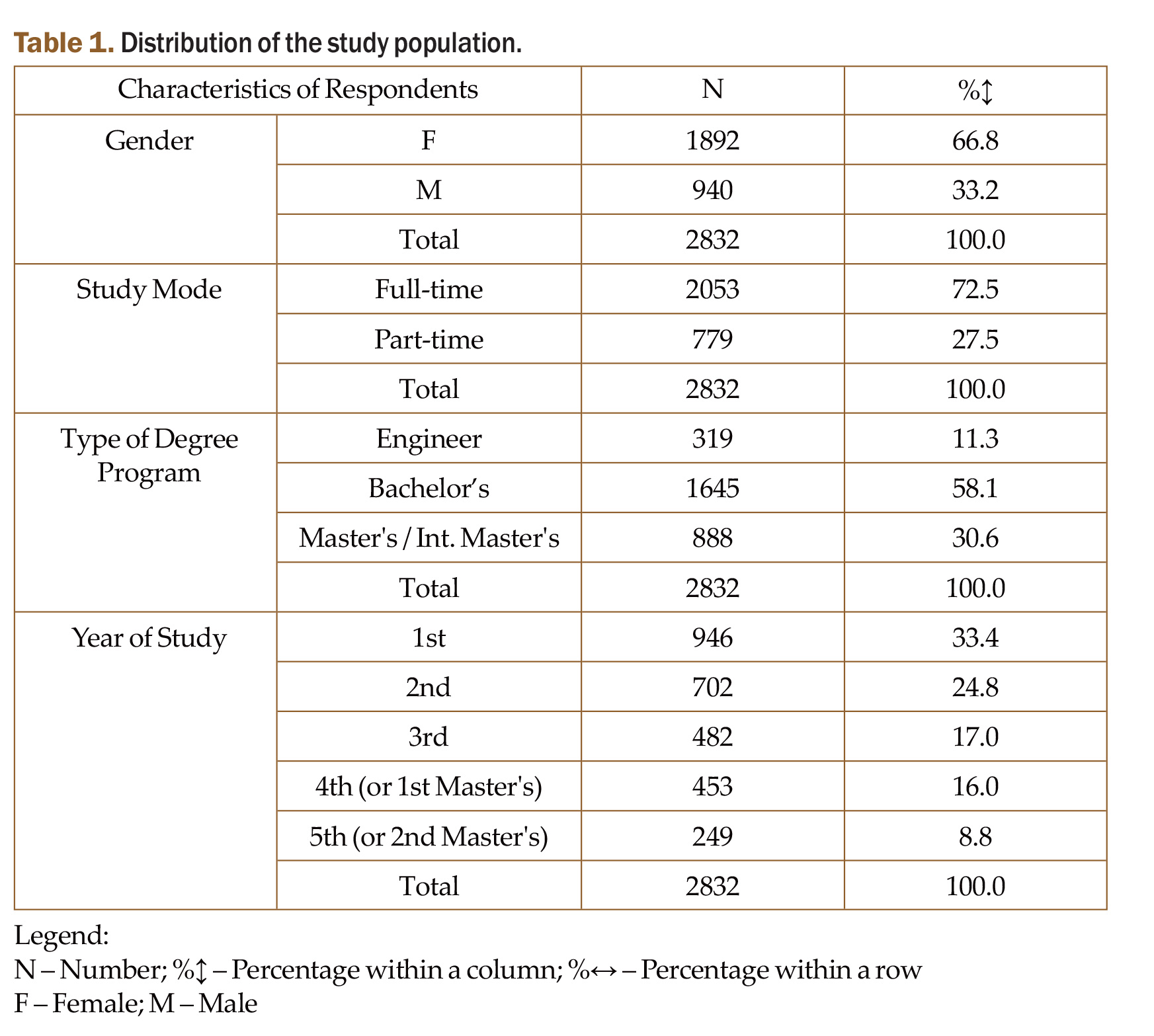
The PS IMAGO Pro 10 (IBM SPSS Statistics 29) statistical package was utilized to analyze the collected data. A five-point Likert scale was employed to evaluate students’ perceived preparedness of universities to conduct online classes during the COVID-19 pandemic, with values as follows: 1 – very poor preparation, 2 – rather poor preparation, 3 – average preparation, 4 – rather good preparation, and 5 – very good preparation. Assuming equal dis-tances between categories on the ordinal scale, mean values were calculated to rank aspects of university operations, as well as the organization and conduct of classes at the surveyed insti-tutions during the COVID-19 pandemic. Further methodological steps included exploratory factor analysis (EFA), analysis of variance (ANOVA), independent samples t-test, NPS and Spearman’s rank correlation coefficient.
4. Results
The analysis covered two primary sets of variables: the first encompassed those related to the functioning of universities during the COVID-19 pandemic, while the second included variables related to the organization and delivery of online classes at universities during this period. A list of variables along with their mean values is presented in Table 2.
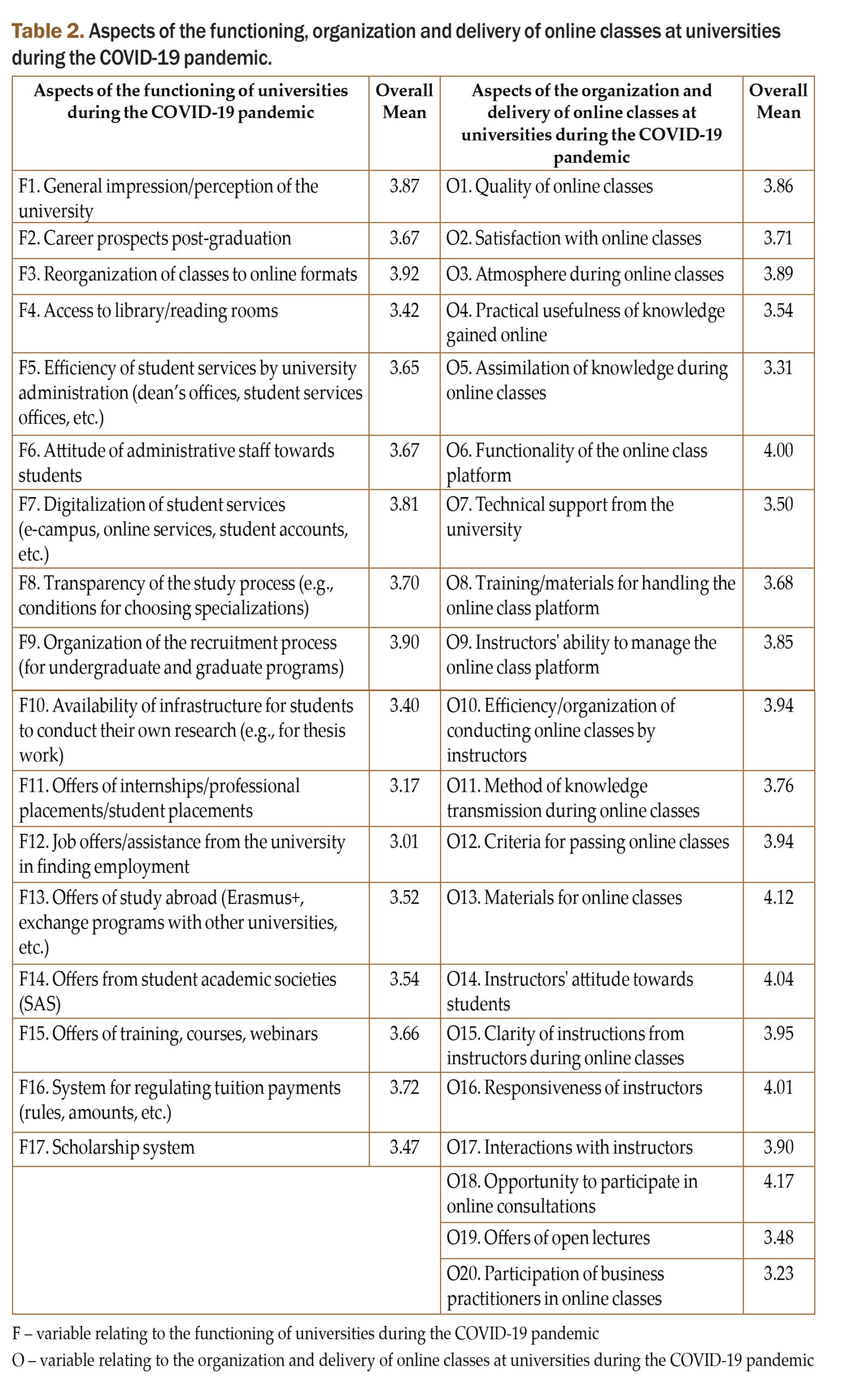
The aspects rated highest by respondents were as follows:
a) reorganization of classes to an online format (x̅3 = 3.92), the organization of the recruitment process (x̅9 = 3.90) and the general impression/perception of the university (x̅1 = 3.87), among the variables related to the functioning of universities during the COVID-19 pandemic,
b) the opportunity to participate in online consultations (x̅19 = 4.17), materials for online classes (x̅13 = 4,12) and instructors’ attitude towards students (x̅14 = 4.04), among the variables related to the organization and delivery of online classes at universities during the COVID-19 pandemic.
Due to the presence of multi-element sets of variables, Exploratory Factor Analysis (EFA) was employed to identify latent dependencies among the studied variables and reduce the number of original variables into newly defined components (Watkins, 2018; Reio & Shuck, 2015; Taherdoost et al., 2014). To assess data quality in the context of EFA, the Kaiser-Meyer-Olkin (KMO) coefficient and Bartlett’s test of sphericity were used – the test values are presented in Tables 3 and 4. In the process of extracting components, the VARIMAX orthogonal rotation was used (Lloret et al., 2017; Goretzko et al., 2021). The results of EFA within the set of variables related to the functioning of universities during the COVID-19 pandemic allowed for the reduction of 17 variables to 2 components 2. The first component includes variables associated with the administrative and organizational efficiency of the university, while the second encompasses variables relating to the offer of professional and academic development (Table 3).
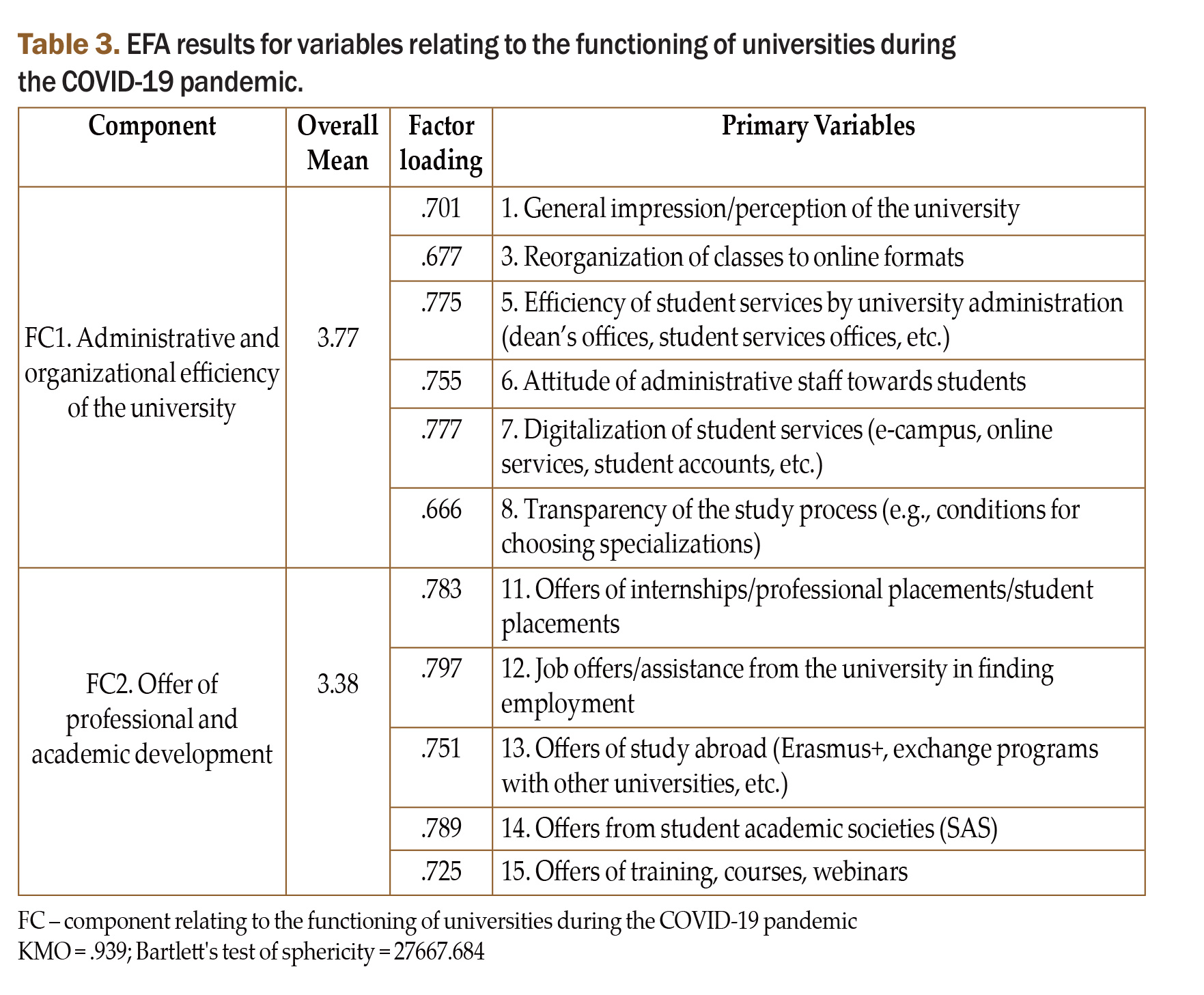 Analysis of the mean values of the new components indicates a higher rating for variables relating to the administrative and organizational efficiency of the university (x̅ = 3.77) than for those addressing the evaluation of the professional and academic development offer (x̅ = 3.38).
Analysis of the mean values of the new components indicates a higher rating for variables relating to the administrative and organizational efficiency of the university (x̅ = 3.77) than for those addressing the evaluation of the professional and academic development offer (x̅ = 3.38).
EFA was subsequently applied to the variables relating to the organization and delivery of online classes at universities during the COVID-19 pandemic. This method allowed the original set of 20 variables to be reduced to 2 distinct components. The first encompasses factors related to technical and didactic support in remote education, while the second includes elements contributing to the atmosphere and practical value of online education (Table 4).
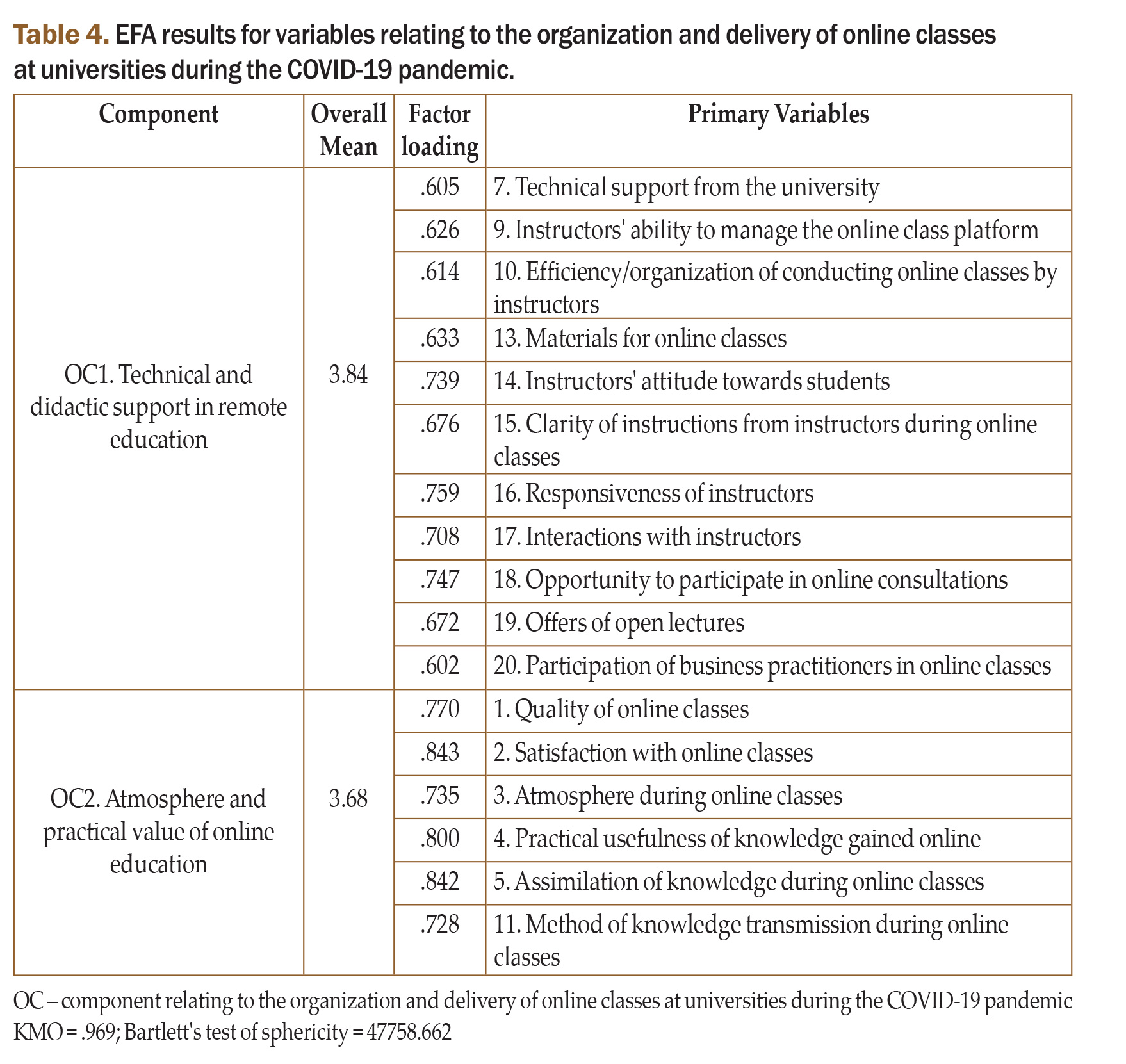
A comparison of mean values for the identified components indicates a higher rating for technical and didactic support in remote education (x̅ = 3.84) than for the atmosphere and practical value of online education (x̅ = 3.68).
Next, the mean values of components identified through EFA were compared based on selected characteristics of the respondents (including included gender, study mode, type of degree program, and year of study) and the likelihood of recommending their HEI to others (in line with the according to the Net Promoter Score framework). A ten-point scale developed by F. Reichheld was used to calculate NPS (Vélez et al., 2020; Reichheld, 2003; Rocks, 2016; Reichheld & Schefter, 2000), where a score of ‘1’ indicated a very low likelihood of recommendation and a score of ‘10’ indicated almost certain recommendation. Responses were categorized into three groups: detractors (scores 1–6), passively satisfied (scores 7–8), and promoters (scores 9–10). The NPS indicator was then calculated by subtracting the percentage of detractors from the percentage of promoters (NPS = P – D). Positive NPS values indicate a higher prevalence of promoters over detractors, signifying favorable evaluations of universities’ preparedness during the COVID-19 pandemic.
The independent samples t-test was applied when there were no more than two groups of respondents, whereas analysis of variance (ANOVA) was used for comparisons across three or more respondent groups (Armstrong et al., 2000; Ferreira et al., 2014). The comparison of university functioning components during the COVID-19 pandemic across selected respondent groups is presented in Table 5.
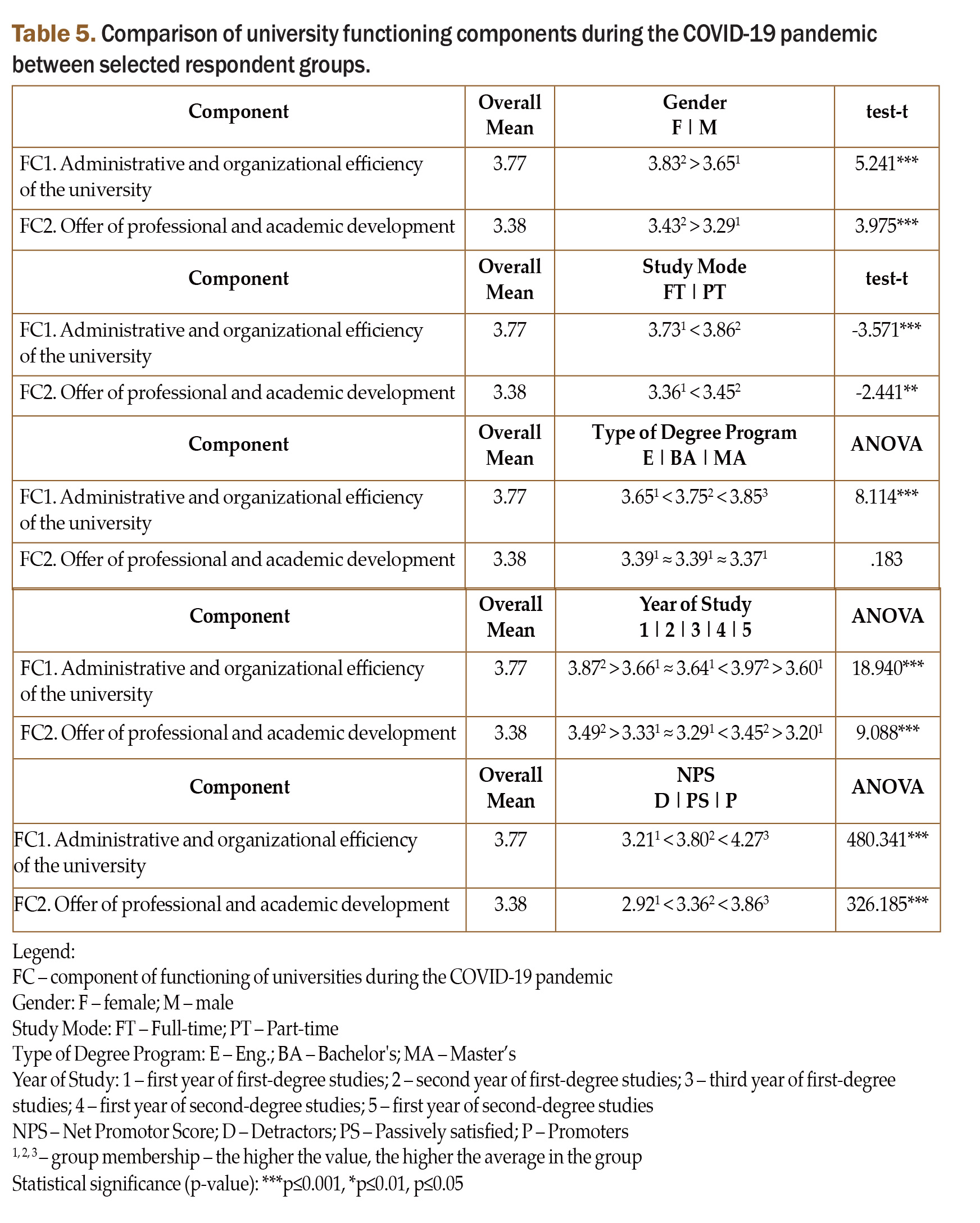
Analysis of these results reveals the following patterns regarding university functioning during the COVID-19 pandemic:
a) Female respondents rated both components higher than male respondents.
b) Part-time students rated both components higher than full-time students.
c) The highest rating for administrative and organizational efficiency was observed among master’s degree students.
d) First-year students, both at the first-degree and second-degree levels, rated both components higher than students in other years.
e) In terms of the NPS framework, promoters had the highest ratings, followed by passively satisfied respondents, whose ratings were higher than those of detractors.
The significance of the identified components related to the functioning of universities during the COVID-19 pandemic was then compared between female and male groups. The obtained results are presented in Table 6.
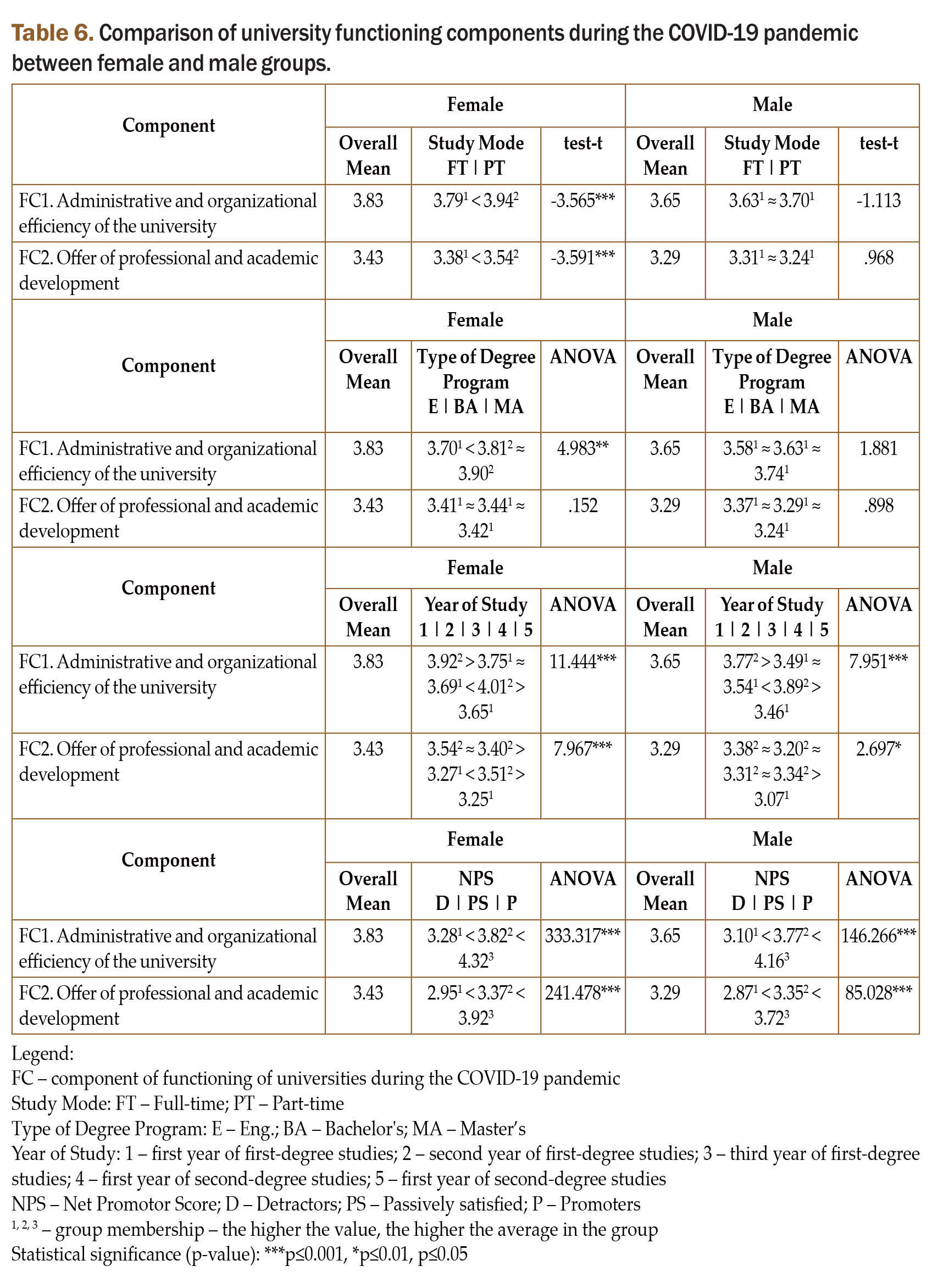
Analysis of the results for university functioning during the COVID-19 pandemic revealed the following patterns:
a) Among female students, part-time students rated both components higher than full-time students. For male students, no statistically significant differences were observed.
b) Female students in bachelor’s and master’s programs rated administrative and organizational efficiency higher than female students in engineering programs; no significant differences were found among male students.
c) First-year female students, at both undergraduate and graduate levels, rated both components higher than females in other years. Among male students, this pattern was observed only in administrative and organizational efficiency (for professional and academic development, the lowest ratings came from males in the final year of graduate studies).
d) In terms of the NPS framework, promoters rated both components highest, followed by passively satisfied respondents, whose ratings were higher than those of detractors. This pattern was consistent across both female and male groups.
Next, the ratings of components related to the organization and delivery of online classes at universities during the COVID-19 pandemic were compared across selected respondent groups. The results are presented in Table 7.
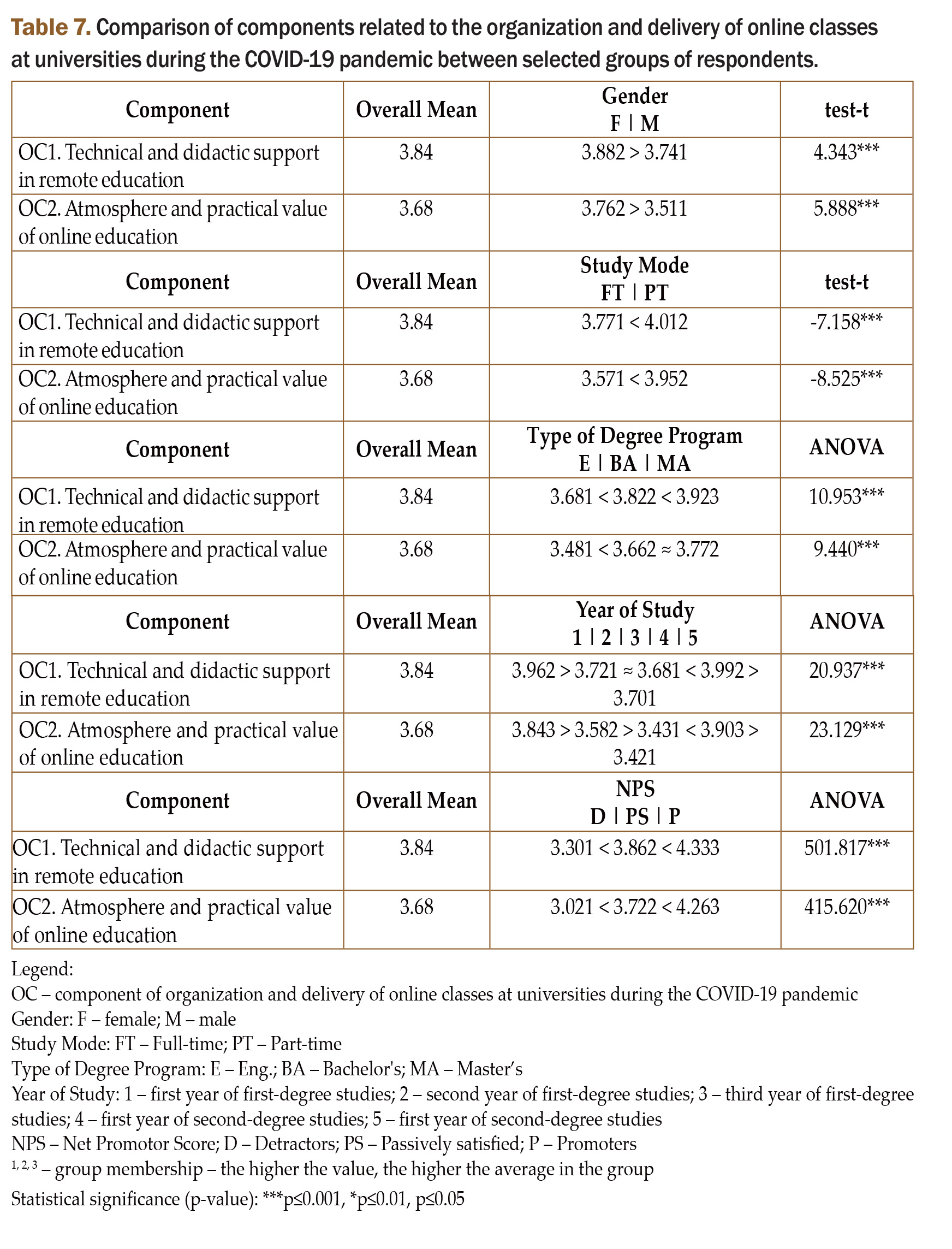
Analysis of these results concerning the organization of online classes during the COVID-19 pandemic revealed the following patterns:
a) Female respondents rated both components higher than male respondents.
b) Part-time students rated both components higher than full-time students.
c) In terms of technical and didactic support in remote education, master’s students provided the highest ratings, followed by bachelor’s students, with the lowest ratings from students in engineering degree programs. For atmosphere and practical value of online education, ratings from master’s and bachelor’s students were higher than those from engineering students.
d) First-year students, both undergraduate and graduate, rated both components higher than students in other years.
e) In terms of recommendation likelihood in the NPS framework, the highest ratings were given by promoters, followed by passively satisfied respondents, with the lowest ratings from detractors.
Additionally, the ratings of components related to the organization and delivery of online classes at universities during the COVID-19 pandemic were compared between female and male groups. The obtained results are presented in Table 8.
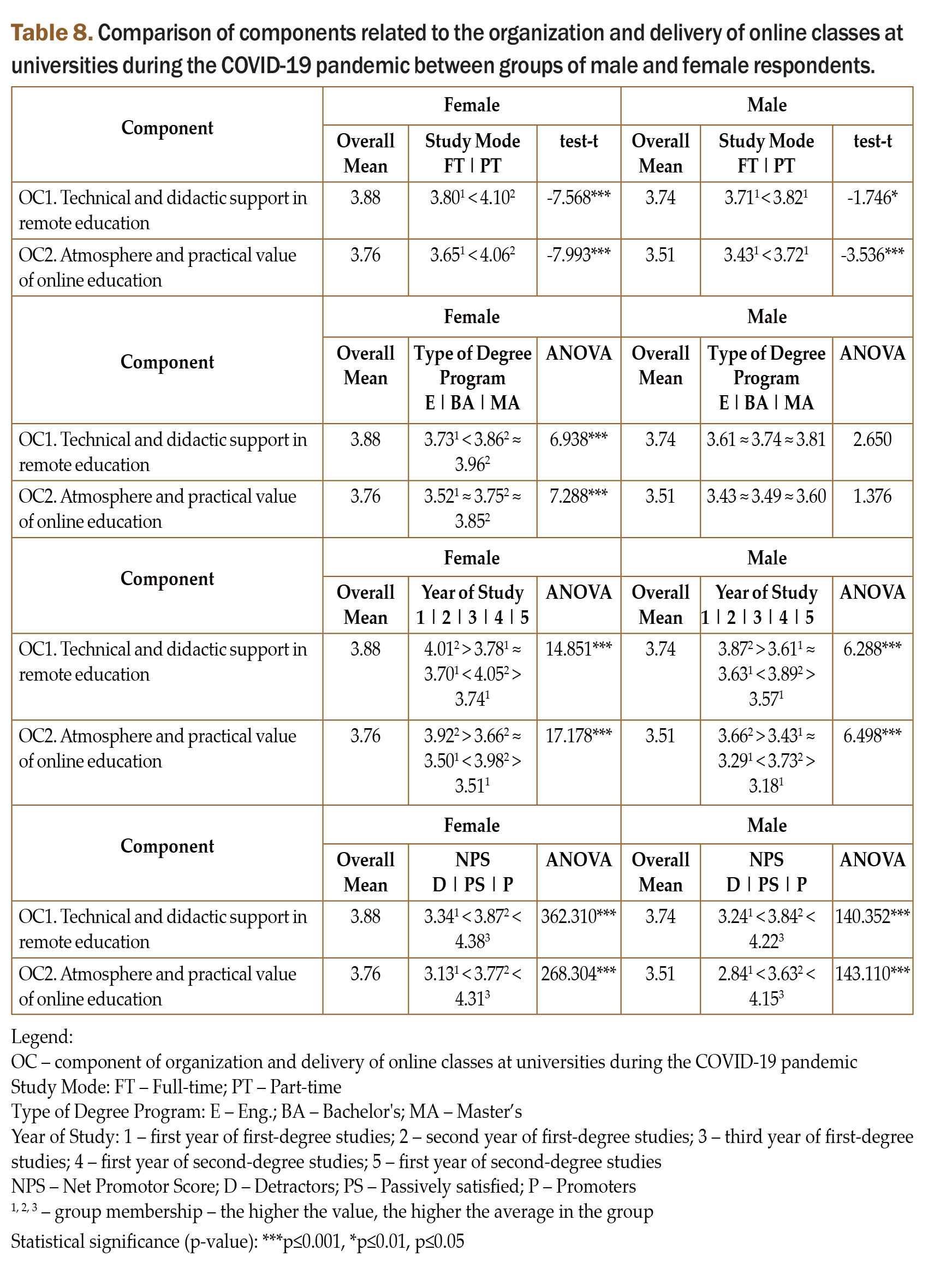
Analysis of the results based on the division into female and male groups evaluating the organization and delivery of online classes during the COVID-19 pandemic reveals the following patterns:
a) Part-time students rated both components higher than full-time students in both female and male groups.
b) Among female students, those in bachelor’s and master’s programs rated university preparedness higher than those in engineering programs. No statistically significant differences were observed among male students.
c) First-year students, both undergraduate and graduate, rated both components higher than students in other years in both gender groups.
d) Promoters gave the highest ratings, passively satisfied respondents gave moderate ratings, and detractors gave the lowest ratings, consistent across both female and male groups.
The final two steps of the research procedure involved assessing the likelihood of university students recommending their institutions to friends or acquaintances. An analysis of the distribution of responses regarding the likelihood of recommendation in selected respondent groups is presented in Table 9.
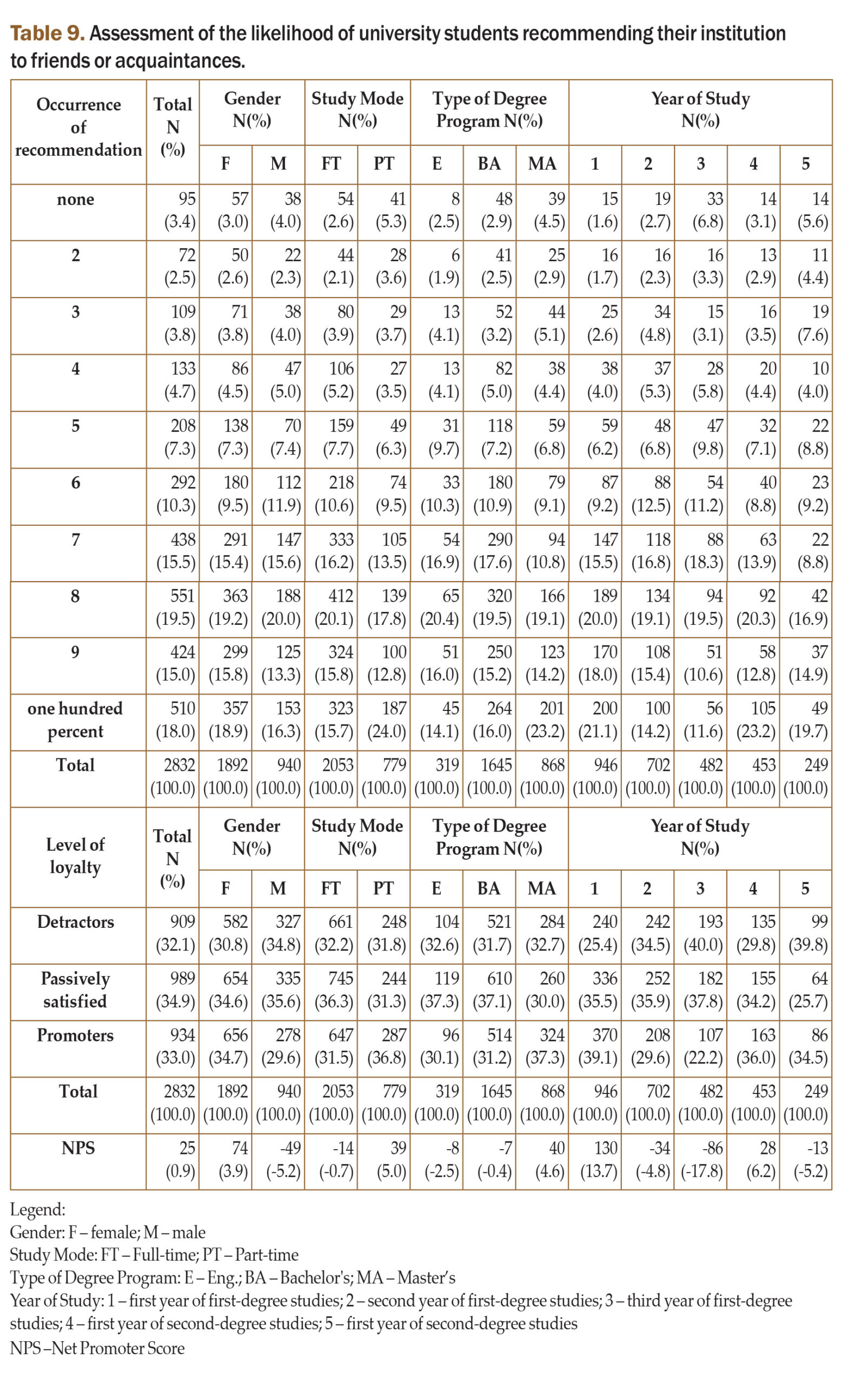
In the first part of Table 9, the distribution of responses regarding the likelihood of recommending their university is shown across groups of students overall, and separately by gender, study mode (full-time or part-time), type of degree program (engineering, bachelor’s, or master’s), and year of study. The analysis reveals positive NPS values in the following groups: overall (+0.9%), female students (+3.9%), part-time students (+5.0%), master’s students (+4.6%), and first-year students of both first-degree studies (+13.7%) and second-degree studies (+6.2%). It should be noted that these positive NPS values are relatively small – except for first-year first-degree students – which may suggest a declining tendency for students to recommend their universities as the duration of their studies increases.
In the final step of the analysis, Spearman’s rank correlation coefficients were calculated to verify the relationship between the level of student loyalty and components related to the functioning, organization, and delivery of online classes during the COVID-19 pandemic. The obtained results are presented in Table 10.
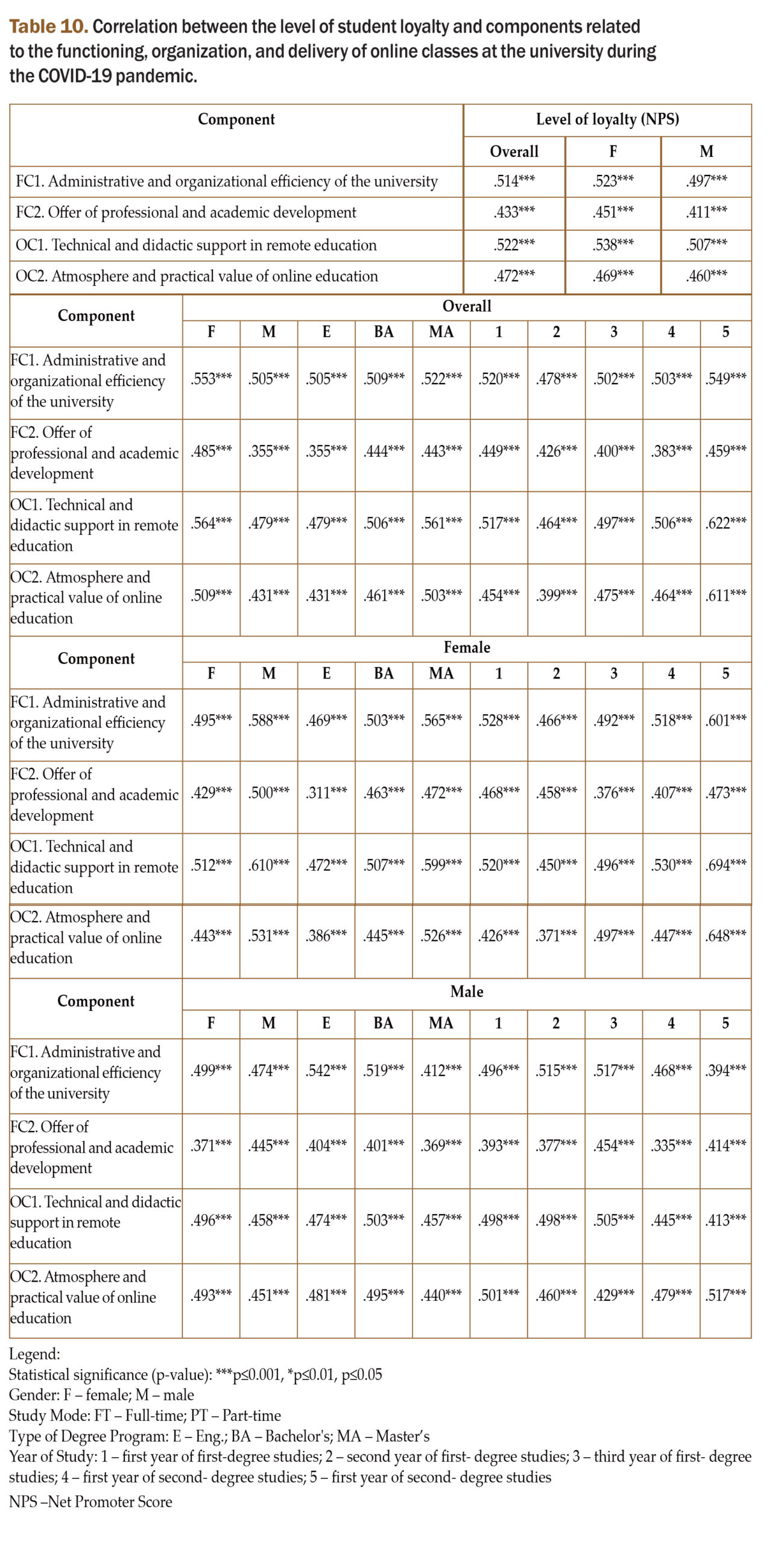
All Spearman’s rank correlation coefficients presented in Table 10 are statistically significant, confirming the presence of relationships between the level of loyalty (as measured using NPS) and the evaluated areas related to the functioning, organization, and delivery of online classes at the university during the COVID-19 pandemic. Among the components related to university functioning, higher correlation values with loyalty are generally observed for FC1 (“Administrative and organizational efficiency of the university”) than for FC2 (“Offer of professional and academic development”); an exception to this pattern is observed in the evaluations of students in the final year of second-degree studies.
Regarding the organization and delivery of online classes, the correlation values with loyalty are generally higher for OC1 (“Technical and didactic support in remote education”) than for OC2 (“Atmosphere and practical value of online education”).
5. Discussion
The study conducted assessed the functioning of higher education institutions in Poland during the COVID-19 pandemic, with a particular focus on university operations as well as the organization and delivery of online classes. Analysis of the results highlighted varied student opinions, which can be grouped into several key areas.
Firstly, in terms of administrative and organizational support, universities were rated relatively high (x̅ = 3.77); notably, female students and part-time students expressed higher satisfaction with the functioning of universities than male students and full-time students. This suggests that these demographic groups may have experienced better alignment between their expectations and the administrative responses of universities during the pandemic.
Similarly, technical and didactic support was also rated highly (x̅ = 3.84), particularly concerning access to materials, platform functionality, and instructor willingness to collaborate and provide responses. Lower ratings were observed for professional and academic development opportunities (x̅ = 3.38) and for the atmosphere and practical value of online classes (x̅ = 3.68), with master’s and bachelor’s students expressing greater satisfaction than engineering students.
In terms of student loyalty, NPS analysis suggests that first-year undergraduate and second-year graduate students exhibit higher loyalty levels. While NPS values were positive, they were generally relatively low, which may indicate a decline in satisfaction as studies progress. This trend warrants further empirical investigation to explore its causes and potential remedies. These observations are further supported by factors influencing loyalty levels – the strongest correlations with student loyalty were observed for FC1. Administrative and organizational efficiency of the university and OC1. Technical and didactic support in remote education. Notably, higher correlation values were found among female students and part-time students.
6. Limitations and future research directions
This study has a number of limitations. The first pertains to its geographic scope: the survey was carried out solely among Polish students; therefore, its findings may contribute to the scientific discussion on evaluating actions taken by HEIs during the COVID-19 pandemic, but the conclusions are only locally applicable. Additionally, the respondents were students of economics programs, which further narrows the scope. Expanding the study to include students from other disciplines and incorporating a broader set of variables is recommended to enhance the applicability of the findings.
A number of avenues remain open for future research. First, attention could be directed toward analyzing long-term relationships between online education and loyalty (especially considering the observed declines in loyalty in later years of study). Such longitudinal studies could provide insights into the potential for a lasting relationship between remote education experiences and students’ perceptions of their studies, and, consequently, their loyalty. Comparative studies focusing on differences between universities in Poland and abroad could also be beneficial, identifying the most effective practices in online education. Additionally, the role of social interactions and psychological support could be analyzed, particularly regarding the role of atmosphere and interaction in online education. Qualitative research would be especially suitable for exploring the impact of limited interaction on student motivation.
From the perspective of recommendation likelihood, an interesting research direction could involve evaluating the effectiveness of various hybrid education models. This could be informed by variations in satisfaction based on the type of degree program (engineering, bachelor’s, and master’s), with specific attention to verifying how different hybrid models cater to student needs according to the nature of their study programs. Furthermore, applying loyalty indicators to assess specific universities could provide deeper insights: the results from ANOVA analyses and statistically significant correlation findings suggest the utility of NPS in evaluating university preparedness. Exploring diverse educational environments unique to different higher education institutions could be insightful in this regard.
Conducting further research in these areas would enable higher education institutions to better tailor management strategies and online class organization to student expectations, ultimately increasing loyalty toward universities in evolving educational contexts.
References
Alexa, L., et al. (2022). Exploring Romanian engineering students’ perceptions of Covid-19 emergency e-learning situation: A mixed-method case study. The Electronic Journal of e-Learning, 20(1), 19–35.
Alves dos Reis, C. A., Simões, M., & Flores-Tena, M. (2021). Students’ pre and post COVID-19 perception of higher education switch to online: An exploratory study in Portugal. Cypriot Journal of Educational Science, 16(5), 2368–2377.
Armstrong, R. A., Slade, S. V., Eperjesi, F. (2000). An introduction to analysis of variance (ANOVA) with special reference to data from clinical experiments in optometry, Ophthal. Physiol. Opt., 20(3), 235–241. onlinelibrary.wiley.com/doi/10.1046/j.1475-1313.2000.00502.x.
Behera, A. K., de Sousa, R. A., Oleksik, V., Dong, J., & Fritzen, D. (2023). Student perceptions of remote learning transitions in engineering disciplines during the COVID-19 pandemic: A cross-national study. European Journal of Engineering Education, 48(1), 110–142. https://doi.org/10.1080/03043797.2022. 2080529.
Biswas, B., Roy, S. K., & Roy, F. (2020). Students’ perception of mobile learning during COVID-19 in Bangladesh: University student perspective. Aquademia, 4(2), ep20023. https://doi.org/10.29333/aquademia/8443.
Borishade, T. T., Ogunnaike, O. O., Salau, O., Motilewa, B. D., & Dirisu, J. I. (2021). Assessing the relationship among service quality, student satisfaction, and loyalty: The Nigerian higher education experience. Heliyon, 7(1). https://doi.org/10.1016/j.heliyon.2021.e07590.
Bouranta, N., Psomas, E.L. and Kafetzopoulos, D. (2024), „Integrating online learning into service quality assessment in higher-education its influence on student satisfaction”, The TQM Journal, Vol. ahead-of-print No. ahead-of-print. https://doi.org/10.1108/TQM-06-2023-0180.
Camilleri, M. A. (2021). Evaluating service quality and performance of higher education institutions: A systematic review and a post COVID-19 outlook. International Journal of Quality and Service Sciences, 13(2). https://doi.org/10.1108/IJQSS-03-2020-0034.
Chukwuere, J. (2024). Rapid review of the COVID-19 pandemic’s impact on the digitalization of higher education. Research on Education and Media, 16(1), 1-9. https://doi.org/10.2478/rem-2024-0002.
Cicha, K., Rizun, M., Rutecka, P., & Strzelecki, A. (2021). COVID-19 and higher education: First-year students’ expectations toward distance learning. Sustainability, 13(4), 1889. https://doi.org/10.3390/ su13041889.
Conrad, C., Deng, Q., Caron, I., Shkurska, O., Skerrett, P., & Sundararajan, B. (2022). How student perceptions about online learning difficulty influenced their satisfaction during Canada’s Covid-19 response. British Journal of Educational Technology, 53, 534–557. https://doi.org/10.1111/bjet.13206.
Cordova, M., Floriani, D. E., Gonzalez-Perez, M. A., Hermans, M., Mingo, S., Monje-Cueto, F., Nava-Aguirre, K. M., Rodriguez, C. A., & Salvaj, E. (2021). COVID-19 and higher education: Responding to local demands and the consolidation of e-internationalization in Latin American universities. Academia Revista Latinoamericana de Administración, 34(4), 493–509. https://doi.org/10.1108/ARLA-01-2021-0020.
Cramarenco, R. E., Burcă-Voicu, M. I., & Dabija, D.-C. (2023). Student perceptions of online education and digital technologies during the COVID-19 pandemic: A systematic review. Electronics, 12(2), 319. https://doi.org/10.3390/electronics12020319.
Cranfield, D. J., Tick, A., Venter, I. M., Blignaut, R. J., & Renaud, K. (2021). Higher education students’ perceptions of online learning during COVID-19—A comparative study. Education Sciences, 11(8), 403. https://doi.org/10.3390/educsci11080403.
Cruz, J. O., Moreno, E. E., & Silupu, W. C. (2019). Effect of the implementation of university accreditation on the satisfaction of engineering students using the Net Promoter Score. 2019 IEEE Sciences and Humanities International Research Conference (SHIRCON), 1–4. https://doi.org/10.1109/SHIRCON 48091.2019.9024870.
Ferreira, E.B., Cavalcanti, P.P., Nogueira, D.A. (2014). ExpDes: An R Package for ANOVA and Experimental Designs, Applied Mathematics, 5(19), 2952–2958. http://dx.doi.org/10.4236/am.2014.519280.
Fuchs, K. (2021). Students’ Perceptions Concerning Emergency Remote Teaching During COVID-19: A Case Study between Higher Education Institutions in Thailand and Finland. Perspectives on Global Development and Technology, 20(3), 278-288. https://doi.org/10.1163/15691497-12341595.
Furiv, U., Kohtamäki, V., Balbachevsky, E., & Virta, S. (2021). COVID-19 Crisis Response of Higher Education Institutions: Tampere University (TAU) and University of São Paulo (USP). In T. Connolly, & S. Farrier (Eds.), Leadership and Management Strategies for Creating Agile Universities, IGI Global. https://doi.org/10.4018/978-1-7998-8213-8.
German, E., & Lestari, D. E. (2021). Teachers and students’ Net Promoter Score (NPS) on the Cambridge Learning Management System (CLMS). Journal of English Teaching, Applied Linguistics and Literatures (JETALL), 4(2), 141. https://doi.org/10.20527/jetall.v4i2.9708.
Gonzalez-Ramirez, J., Mulqueen, K., Zealand, R., Silverstein, S., Mulqueen, C., & BuShell, S. (2021). Emergency online learning: college students’ perceptions during the COVID-19 pandemic. College Student Journal, 55(1), 29-46.
Goretzko, D., Huong Pham, T. T., Bühner, M. (2021). Exploratory factor analysis: Current use, methodological developments and recommendations for good practice, Current Psychology, 40, pp. 3510–3521. https://doi.org/10.1007/s12144-019-00300-2.
Guzmán Rincón, A., Sotomayor Soloaga, P. A., Carrillo Barbosa, R. L., & Barragán-Moreno, S. P. (2024). Satisfaction with the institution as a predictor of the intention to drop out in online higher education. Cogent Education, 11(1). https://doi.org/10.1080/2331186X.2024.2351282.
Iqbal, S. A., Ashiq, M., Rehman, S. U., Rashid, S., & Tayyab, N. (2022). Students’ perceptions and experiences of online education in Pakistani universities and higher education institutes during COVID-19. Education Sciences, 12(3), 166. https://doi.org/10.3390/educsci12030166.
Krishnan, N., & Sharma, R. (2021). Student perception of online teaching in higher education institutions during COVID-19 pandemic: A survey study. Journal of Ayurveda and Integrated Medical Sciences, 6(6), 48–61. Retrieved from https://www.jaims.in/jaims/article/view/1528.
Kulikowski, K., Przytula, S., & Sulkowski, L. (2021). Emergency forced pandemic e-learning – feedback from students for HEI management. Open Learning: The Journal of Open, Distance and e-Learning, 36(3), 245–262. https://doi.org/10.1080/02680513.2021.1942810.
Kundu, A., & Bej, T. (2021). COVID-19 response: Students’ readiness for shifting classes online. Corporate Governance, 21(6), 1250–1270. https://doi.org/10.1108/CG-09-2020-0377.
Lapina, I., Roga, R. and Müürsepp, P. (2016), „Quality of higher education: International students’ satisfaction and learning experience”, International Journal of Quality and Service Sciences, 8(3), 263–278. https://doi.org/10.1108/IJQSS-04-2016-0029.
Lloret, S., Ferreres, A., Hernández, A. Tomás, I. (2017). The exploratory factor analysis of items: guided analysis based on empirical data and software, Anales de psicología, 33(2), 417–432. http://dx.doi.org/ 10.6018/analesps.33.2.270211.
Matarirano, O., Gqokonqana, O. & Yeboah, A. (2021). Students’ Responses to Multi-Modal Emergency Remote Learning During COVID-19 in a South African Higher Institution. Research in Social Sciences and Technology, 6(2), 199–218. https://doi.org/10.46303/ressat.2021.19
Mattah, P. A. D., Kwarteng, A. J., & Mensah, J. (2018). Indicators of service quality and satisfaction among graduating students of a higher education institution (HEI) in Ghana. Higher Education Evaluation and Development, 12(1), 36–52. https://doi.org/10.1108/HEED-10-2017-0006.
Maydiantoro, A.A., Winatha, I.K., Riadi, B., Hidayatullah, R., Putrawan, G.E., & Dzakiria, H. (2020). (Emergency) Online Remote Learning in Higher Education Institutions during COVID-19 Crisis: Students’ Perception of the Situation. Universal Journal of Educational Research 8(12), 6445—6463. https://doi.org/10.13189/ujer.2020.081210.
Mospan, N. V., Ognevyuk, V. O., & Sysoieva, S. S. (2022). Emergency higher education digital transformation: Ukraine’s response to the COVID-19 pandemic. Information Technologies and Learning Tools, 89(3), 90–104. https://doi.org/10.33407/itlt.v89i3.4827.
NIK. (2021). Funkcjonowanie szkół w sytuacji zagrożenia COVID-19 [School Function in the Situation of COVID-19 Threat]. Najwyższa Izba Kontroli. Retrieved from https://www.nik.gov.pl/kontrole/P/21/021.
Oleksiyenko, A., Mendoza, P., Riaño, F. E. C., Dwivedi, O. P., Kabir, A. H., Kuzhabekova, A., Charles, M., Ros, V., & Shchepetylnykova, I. (2022). Global crisis management and higher education: Agency and coupling in the context of wicked COVID-19 problems. Higher Education Quarterly, 77(2), 356–374. https://doi.org/10.1111/hequ.12406.
Packmohr, S., & Brink, H. (2021). Comparing pre- and intra-COVID-19 students’ perception of the digitalization of higher education institutions. In Proceedings of the 7th International Conference on Higher Education Advances (HEAd’21) (p. 13044). Universitat Politècnica de València. http://dx.doi.org/10.4995 /HEAd21.2021.13044.
Reichheld, F. F. (2003). The one number you need to grow. Harvard Business Review, December, 81(12), 46–54.
Reichheld, F. F., Schefter P. (2000). E-Loyalty: Your Secret Weapon on the Web, Harvard Business Review, July/August, 78(4).
Reio, T. G., & Shuck, B. (2015). Exploratory Factor Analysis: Implications for Theory, Re-search, and Practice. Advances in Developing Human Resources, 17(1), 12–25. https://doi.org/10.1177/1523422314559804.
Rocks, B. (2016). Interval Estimation for the “Net Promoter Score”, The American Statistician, 70(4), 365–372. https://doi.org/10.1080/00031305.2016.1158124.
Saleh, N. F., & Jalambo, M. O. (2022). Female students’ perception of m-learning in the higher education institutions of Palestine during the COVID-19 pandemic. Cogent Education, 9(1), 2147775. https://doi.org/10.1080/2331186X.2022.2147775.
Shamsir, M. S., Krauss, S. E., Ismail, I. A., et al. (2022). Development of a Haddon Matrix framework for higher education pandemic preparedness: Scoping review and experiences of Malaysian universities during the COVID-19 pandemic. Higher Education Policy, 35, 439–478. https://doi.org/10.1057/s41307-020-00221-x.
Taherdoost, H., Sahibuddin, S., Jalaliyoon, N. (2014). Exploratory Factor Analysis: Concepts and Theory. In J. Balicki (Ed.), Advances in Applied and Pure Mathematics (Vol. 27, pp. 375–382). WSEAS. Mathematics and Computers in Science and Engineering Series. https://hal.archives-ouvertes.fr/hal-02557344.
Turnbull, D., Chugh, R., & Luck, J. (2021). Transitioning to e-learning during the COVID-19 pandemic: How have higher education institutions responded to the challenge? Education and Information Technologies, 26, 6401–6419. https://doi.org/10.1007/s10639-021-10633-w.
Vélez, D., Ayuso, A., Perales-González, C., Tinguaro Rodríguez, J. (2020). Churn and Net Promoter Score forecasting for business decision-making through a new stepwise regression methodology, Knowledge-Based Systems, 196. https://doi.org/10.1016/j.knosys.2020.105762.
Watkins, M.W. (2018). Exploratory Factor Analysis: A Guide to Best Practice, Journal of Black Psychology, 44(3), 219–246. https://doi.org/10.1177/0095798418771807.
Zamora-Antuñano, M. A., Rodríguez-Reséndiz, J., Cruz-Pérez, M. A., Reséndiz Reséndiz, H., Paredes-García, W. J., & Díaz, J. A. G. (2022). Teachers’ perception in selecting virtual learning platforms: A case of Mexican higher education during the COVID-19 crisis. Sustainability, 14(1), 195. https://doi.org/10.3390/su14010195.
Zizka, L., & Probst, G. (2022). Teaching during COVID-19: Faculty members’ perceptions during and after an “exceptional” semester. Journal of International Education in Business, 15(2), 202–220. https://doi.org/10.1108/JIEB-12-2020-0099.
Bogdan Sojkin, Łukasiewicz Research Network – Institute of Aviation, Poland – Prof. Ph.D. in economic sciences, Former employee of the Poznań University of Economics, Poland, Former head of the Department of Product Marketing at the Faculty of Commodity Science of the Poznań University of Economics, Interests and research activities focus on the problems of: product management, market and marketing research, system marketing information and sports marketing.
Paweł Bartkowiak, Poznań University of Economics and Business, Poland — PhD in economic sciences, Assistant Professor at the Department of Strategic Management, Poznań University of Economics and Business. His main research interests include processes of value cocreation, determinants of consumers’ market behavior, project management and strategic decision-making at enterprises. He teaches courses in strategic management, project management and market and marketing research.
Szymon Michalak, Poznań University of Economics and Business, Poland — PhD in economic sciences, Assistant Professor in the Product Marketing Department of Poznań University of Economics and Business. His main research interests include consumer attitudes towards product innovation and consumer involvement in value co-creation. A team member on projects with EU funding, as well as projects for enterprises, local government units, and the Polish Ministry of Agriculture and Rural Development. He teaches such subjects as Innovation Management, Product Management, Marketing Research, and Enterprise Management.

